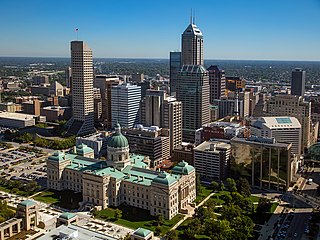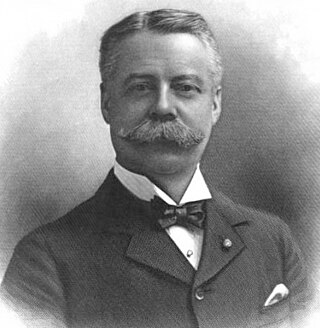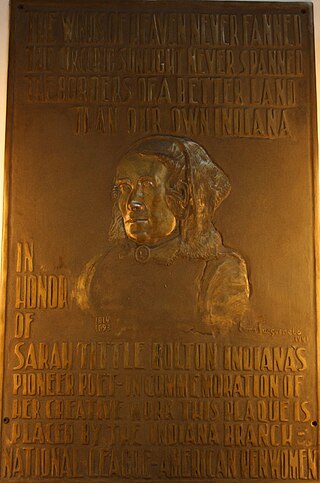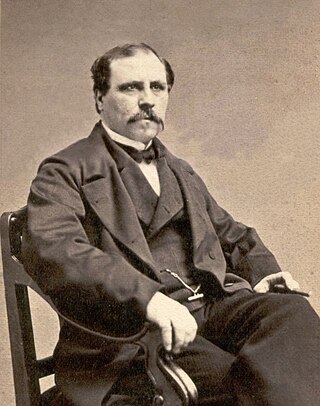
Indianapolis, colloquially known as Indy, is the capital and most populous city of the U.S. state of Indiana and the seat of Marion County. Indianapolis is situated in the state's central till plain region along the west fork of the White River. The city's official slogan, "Crossroads of America", reflects its historic importance as a transportation hub and its relative proximity to other major North American markets.

William Hayden English was an American politician. He served as a U.S. Representative from Indiana from 1853 to 1861 and was the Democratic Party's nominee for Vice President of the United States in 1880.

Thomas Taggart was an Irish-American politician who was the political boss of the Democratic Party in Indiana for the first quarter of the twentieth century and remained an influential political figure in local, state, and national politics until his death. Taggart was elected auditor of Marion County, Indiana (1886–1894), and mayor of Indianapolis. His mayoral administration supported public improvements, most notably the formation of the city's park and boulevard system. He also served as a member of the Democratic National Committee (1900–1916) and as its chairman (1904–1908). Taggart was appointed to the U.S. Senate in March 1916, but lost the seat in the November election.

George Ade was an American writer, syndicated newspaper columnist, librettist, and playwright who gained national notoriety at the turn of the 20th century with his "Stories of the Streets and of the Town", a column that used street language and slang to describe daily life in Chicago, and a column of his fables in slang, which were humorous stories that featured vernacular speech and the liberal use of capitalization in his characters' dialog.

Lambdin Purdy Milligan was an American lawyer and farmer who was the subject of Ex parte Milligan 71 U.S. 2 (1866), a landmark case by the Supreme Court of the United States. He was known for his extreme opinions on states' rights and his opposition to the Lincoln administration's conduct of the American Civil War.

Downtown Indianapolis is a neighborhood area and the central business district of Indianapolis, Indiana, United States. Downtown is bordered by Interstate 65, Interstate 70, and the White River, and is situated near the geographic center of Marion County. Downtown has grown from the original 1821 town plat—often referred to as the Mile Square—to encompass a broader geographic area of central Indianapolis, containing several smaller historic neighborhoods.

The history of Indianapolis spans three centuries. Founded in 1820, the area where the city now stands was originally home to the Lenape. In 1821, a small settlement on the west fork of the White River at the mouth of Fall Creek became the county seat of Marion County, and the state capital of Indiana, effective January 1, 1825. Initially the availability of federal lands for purchase in central Indiana made it attractive to the new settlement; the first European Americans to permanently settle in the area arrived around 1819 or early 1820. In its early years, most of the new arrivals to Indianapolis were Europeans and Americans with European ancestry, but later the city attracted other ethnic groups. The city's growth was encouraged by its geographic location, 2 miles (3.2 km) northwest of the state's geographic center. In addition to its designation as a seat of government, Indianapolis's flat, fertile soil, and central location within Indiana and the Midwest, helped it become an early agricultural center. Its proximity to the White River, which provided power for the town's early mills in the 1820s and 1830s, and the arrival of the railroads, beginning in 1847, established Indianapolis as a manufacturing hub and a transportation center for freight and passenger service. An expanding network of roads, beginning with the early National Road and the Michigan Road, among other routes, connected Indianapolis to other major cities.
Richard Buckner Gruelle was an American Impressionist painter, illustrator, and author, who is best known as one of the five Hoosier Group artists. Gruelle's masterwork is The Canal—Morning Effect (1894), a painting of the Indianapolis, Indiana skyline, but he is also known for his watercolors and marine landscapes of the Gloucester, Massachusetts, area. In 1891 Indiana poet James Whitcomb Riley commissioned Gruelle to illustrate two of his more notable poems, "When the Frost is on the Punkin'" and "The Old Swimmin' Hole," which were published in Neighborly Poems (1891). Gruelle is also the author of Notes, Critical and Biographical: Collection of W. T. Walters (1895), which provides a detailed description of Baltimore industrialist William Thompson Walters's extensive art collection.

William Eastin English was an American attorney and politician, a U.S. Representative from Indiana. He was the son of vice-presidential candidate and businessman, William Hayden English, and his wife Emma Mardulia Jackson.
During the American Civil War, Indianapolis, the state capital of Indiana, was a major base of supplies for the Union. Governor Oliver P. Morton, a major supporter of President Abraham Lincoln, quickly made Indianapolis a gathering place to organize and train troops for the Union army. The city became a major railroad hub for troop transport to Confederate lands, and therefore had military importance. Twenty-four military camps were established in the vicinity of Indianapolis. Camp Morton, the initial mustering ground to organize and train the state's Union volunteers in 1861, was designated as a major prisoner-of-war camp for captured Confederate soldiers in 1862. In addition to military camps, a state-owned arsenal was established in the city in 1861, and a federal arsenal in 1862. A Soldiers' Home and a Ladies' Home were established in Indianapolis to house and feed Union soldiers and their families as they passed through the city. Indianapolis residents also supported the Union cause by providing soldiers with food, clothing, equipment, and supplies, despite rising prices and wartime hardships, such as food and clothing shortages. Local doctors aided the sick, some area women provided nursing care, and Indianapolis City Hospital tended to wounded soldiers. Indianapolis sent an estimated 4,000 men into military service; an estimated 700 died during the war. Indianapolis's Crown Hill National Cemetery was established as one of two national military cemeteries established in Indiana in 1866.

The Old National Centre, formerly known as the Murat Shrine Temple and the Murat Shrine Center, is located at North and New Jersey streets in Indianapolis, Indiana, and is owned by the Murat Shriners of the Ancient Arabic Order of the Nobles of the Mystic Shrine. The theater portion of the building is now known as the Murat Theatre at Old National Centre or simply the Murat Theatre and houses the oldest extant stage house in downtown Indianapolis. It is the only Shrine Center in the world with a name of French origin and is the largest Shrine Center in North America.

The Hilbert Circle Theatre, originally called the Circle Theatre, is in Indianapolis, Indiana, on Monument Circle in the Washington Street-Monument Circle Historic District. It was originally built in 1916 as a "deluxe movie palace" and now is the home of the Indianapolis Symphony Orchestra.

Benjamin Harrison is a public artwork by American artist Charles Henry Niehaus, located in University Park in downtown Indianapolis, Indiana, United States. It is a full-length bronze sculptural portrait of Benjamin Harrison, the 23rd president of the United States, the only U.S. president from Indiana.
The Indianapolis Journal was a newspaper published in Indianapolis, Indiana, during the nineteenth and early twentieth centuries. The paper published daily editions every evening except on Sundays, when it published a morning edition.

Sarah T. Bolton is a public artwork by American artist Emma Sangernebo (1877–1969). It is located on the second floor of the rotunda in the Indiana State House, Indianapolis, Indiana, United States. It is a bronze sculptural relief of Indiana poet Sarah Tittle Bolton, née Barrett and contains four lines from Bolton's poem "Indiana".

William H. English is a public artwork by an unknown artist, located in a niche on the third floor of the Indiana Statehouse, which is in Indianapolis, Indiana, United States of America.

Robert Auguste Stoepel was a German-born American composer and conductor. His compositions include Hiawatha, a symphony for orchestra and vocal soloists, as well as incidental music for plays, piano works, songs, and several operas. Born in Berlin, Stoepel worked in Paris and London, but spent a large portion of his career in New York City where he died at the age of 66. From 1857 until their separation in 1869, he was married to the actress Matilda Heron. Their daughter Bijou Heron was also an actress.

The Indianapolis Freeman (1884–1926) was the first illustrated black newspaper in the United States. Founder and owner Louis Howland, who was soon replaced by Edward Elder Cooper, published its first print edition on November 20, 1884.
Freeman Briley Ransom (1880–1947) was an American lawyer, businessman and civic activist in Indianapolis, Indiana. From 1911 until his death he served as legal counsel and general manager for the Madame C.J. Walker Manufacturing Company as well as Madame C.J. Walker's personal attorney. Robert Brokenburr was his law partner.














